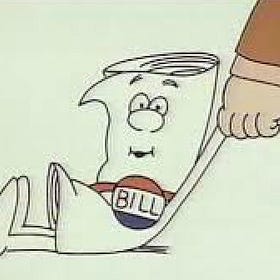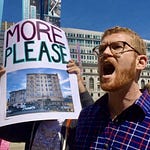This was a fascinating conversation that took aim, center-mass, at many of the mainstream housing narratives. Suffice it to say, Cameron Murray — an economist and consultant who specialises in property markets, environmental economics, and corruption — is a YIMBY-skeptic.
He has done some interesting work in demystifying the housing debate, and is also the author of a 2024 book titled The Great Housing Hijack. Check out his Substack publication, Fresh Economic Thinking.
A side note: Unencumbered by prevailing dogma and in service of our mission to discover and propose bold, asymmetric policy solutions, we are fully committed to hearing and considering the full range of perspectives on housing. If Dr. Murray views the Glaeser Pill as nonsense — he’s articulated such a view here, here, and here — regardless of our priors, we want to hear him make his case.
As for whether he’s right, we’ll leave that up to the commenters — for now!
Reframing the Problem (00:01:18–00:04:24)
The fundamental starting point reshapes everything: a housing crisis isn’t simply a market behaving abnormally. Understanding housing requires recognizing that it represents roughly a quarter of the entire economy, with nearly 10% of the workforce engaged in building and maintaining homes. This scale imposes hard constraints that no amount of policy tinkering can overcome.
The housing market operates under basic economic forces that existed in 1836 Sydney with Charles Darwin, when “the number of new homes recently built is truly surprising. Nevertheless, everyone complains of the high rents and difficulty in procuring a house” — suggesting the problem isn’t new policy, but rather the nature of economic growth itself.
Comparing living standards across decades reveals the actual achievement: homes are 50% bigger, there are far fewer people per unit, and we have dramatically more amenities, yet we frame this as crisis rather than success.
Population growth doesn’t drive housing constraints; spatial equilibrium — the rental gradient between cities — contains economic information about what makes locations valuable, not evidence that regulations prevent building.
Supply Curves Don’t Lower Prices, Rich Societies Do (00:05:06–00:07:41)
A supply curve isn’t simply quantity; it’s the willingness to trade. Increasing housing supply doesn’t reduce prices the way the conventional narrative suggests because it ignores how wealth reshapes demand.
“If you want to fight economic forces, you have to prevent trades that would otherwise occur.” People in rich societies spend their gains on housing, recreation, holidays, and cars — and that’s precisely what has happened. More houses haven’t meant cheaper houses; they’ve meant bigger, better houses with more bathrooms and amenities.
The thought experiment proves it: tell someone from 1980 that by 2025 there are only 2.5 people per home, homes are 50% bigger with better amenities everywhere, yet people call it a housing crisis. They’d laugh — that’s exactly the future path that happened over the past 40 years.
Sellers are economically rational agents just like buyers. If prices are rising, sellers won’t supply housing because they know they own an asset appreciating. This generates the cycle and long-term pricing dynamics regardless of overall quantity.
Interest Rates Create Inescapable Mathematics (00:10:00–00:13:44)
Interest rate policy reveals a fundamental constraint: you cannot maintain the same price-to-income ratio at 4% mortgage rates as at 8% or 9%. When central banks engineered low rates during COVID, higher housing prices were not a side effect — they were the deliberate intended policy outcome.
Post-COVID monetary policy was explicit design, not market failure: central banks globally set interest rates to 2% to stimulate housing buying and construction. Then policy reversed to combat inflation by making housing unaffordable and preventing people from buying. “We’re trying to make it expensive to stop you buying and building houses because we don’t want inflation.”
Housing assets constitute 25% of all balance sheets in Australia (and similar proportions elsewhere). Prices must diverge from incomes when interest rates change. Yields on houses compress to 3% when mortgage rates are 4-5%, and mathematically prices can’t remain stable as rates rise.
Calls for lower prices and higher homeownership are contradictory demands applied to a quarter of the economy. Post-financial crisis, prices fell and homeownership declined — forcing people to choose between them.
Financialization Is Just a Cyclical Renaming (00:14:47–00:17:45)
The framing of housing’s problems as stemming from financialization misses the historical consistency of these dynamics. Archive records from the 1850s show wealthy British investors buying Australian land to exclude locals — the same pattern recycled under new terminology across centuries.
Interest rate spreads between homeowners and investors do shift buyer composition. The 2017 Australian banking inquiry shifted rates to favor homeowners over investors, immediately increasing first-home buyer market share. But this doesn’t fundamentally alter prices because sellers remain rational economic actors; if investors stop buying, they just stop selling.
Preventing trades is what changes prices from equilibrium levels. Rent-to-income ratios stabilize around 26% across decades and geographies. This persistent equilibrium suggests something deeper than policy design — it reflects how people allocate resources when they grow richer. “The market is always at the limit of what people want to pay.”
Policies that redistribute between buyers have been operating for decades. Making public housing versus increasing investor-favorable financing creates different ownership structures but not necessarily different affordability outcomes.
The Spatial Equilibrium Isn’t Evidence of Misallocation (00:29:37–00:34:57)
The YIMBY and abundance movements correctly identify practical problems — minimum parking, accessory dwelling units, infrastructure — but they misdiagnose the underlying constraint. Price differentials between cities aren’t evidence of policy failure; they’re evidence of real economic differences in location value.
Ed Glaeser’s spatial misallocation thesis assumes away the very thing it claims to explain: that San Francisco and Detroit have genuinely different values. “You can’t have a beautiful, rich, cheap city.” The Henry George Theorem suggests perfectly planned cities become the most expensive precisely because they’re best — higher quality of life commands premium prices.
Building taller on a per-saleable-square-meter basis is more expensive, not cheaper. Construction measurement classification games hide productivity: when prefabrication improves, it’s reclassified as manufacturing rather than construction, making construction appear stagnant by accounting artifact.
Texas and Houston with their absence of comprehensive zoning have experienced precisely the same price and rent growth trajectories post-COVID as highly regulated cities. The Gold Coast in Australia, with zero density restrictions, has seen the most dramatic rent growth of any Australian city since COVID. “What else can you do?”
The Cycles Are Normal Economic Turbulence (00:25:43–00:28:47)
Economic growth isn’t evenly distributed; it creates winners and losers. Housing cycles are economically disruptive, but this isn’t a bug that policy can fix — it’s the mechanism through which economies develop. The “puzzling coexistence of progress and poverty” isn’t a housing crisis; it’s how growth happens.
When prices rise, central banks implement interest rate increases, then people call rising affordability challenges a crisis. When prices fall, governments bail people out and celebrate. “Do you want us to dampen the cycle or not?” The contradictory demands reveal that people haven’t clarified what they actually want from policy.
Cyclical growth creates genuine dislocation: industries fail, people move cities, homelessness rises alongside prosperity. This turbulence is real and bundled with cultural consequences, but it exists whether housing policy changes or not. The 1890s already diagnosed this as “the puzzling coexistence of progress and poverty.”
“Plumber Joe” who got rich owning a house without credentials doesn’t diminish the lawyer’s achievements; it’s simply the outcome of temporal ordering. Economic growth requires that certain people climb ranks while others fall behind. People experiencing downward mobility relative to expectations express frustration at housing prices, but this reflects growth dynamics generally.
Building Without Improving Returns Won’t Accelerate Construction (00:36:25–00:42:30)
A core misconception: lowering regulatory costs increases construction speed and quantity. In reality, the decision to build hinges on the trade-off between building now versus building later. Reducing input costs makes houses bigger and better, not more numerous or faster to build.
“Regulatory tax” arguments conflate taxes and regulations into invented constructs. Reducing construction costs doesn’t accelerate building because the cost comparison isn’t input cost versus market price — it’s the foregone return from waiting. If I own vacant land earning 5% annual appreciation, lowering my construction costs doesn’t change whether building today or tomorrow makes me more money. Both paths still earn the same expected return.
The New South Wales public housing example illustrates this perfectly: delayed five years selling assets, but eventual sale price rose from $400 million expected to $710 million realized. In growing economies, waiting pays just as much as going because market returns are tied to overall growth, not policy changes.
Filtering effects assume that filtering down the affordability stack will lower prices for lower-income people. But if rents fall, people move there until prices bid back up. This is exactly why prices can’t come down — ”People will move there because it’s absolutely beautiful. If you can rent there for 20% less, why would I not move there?” Spatial reallocation follows, prices reset to equilibrium.
Vienna’s 5% Rent-to-Income Ratio Came at a Price (00:49:06–00:51:00)
The 1920s offer a historical comparison: Vienna achieved 5% rent-to-income ratio versus 26% in the U.S., but through preventing trades entirely. Citizens couldn’t negotiate rental prices or choose where to live; they used central city clearinghouses for allocation. Rents stayed low only because people couldn’t access market alternatives.
Vienna’s system prevented people from trading and relocating their rental homes. Residents requesting larger apartments after having children would wait for central allocation without market negotiation. People hated it because they couldn’t trade and move to preferred locations or suburbs, despite nominally cheap rents.
The mechanism is clear: preventing trades is what changes prices from equilibrium. Those prevented-from-trading prices link to broader national markets with cyclical variation. You can achieve low nominal rent-to-income ratios through coercion, or you can have markets with the equilibrium ratio we see everywhere — but not both.
A rent-to-income ratio of 26% appears persistently across rich economies and decades precisely because it reflects how households allocate resources when richer. More housing hasn’t meant cheaper housing in real terms; it means bigger, better housing with fewer people per unit — essentially the entire improvement of living standards.
Public Housing as Targeted Backstop (00:51:03–00:54:02)
Given the limits of direct market intervention, the practical approach targets the genuinely vulnerable without trying to rewire the entire system. Rather than attempting to lower prices for everyone, public housing provides a backstop for roughly 10% of the population squeezed in private rental markets.
Singapore started at 20% home ownership and reached 90% predominantly through public construction — a national effort comparable to highway construction in the 1960s U.S. Similarly scaled efforts in expensive cities could stabilize working-class residence without attempting the impossible: making San Francisco affordable for everyone.
The actual crisis population isn’t the future IT professional who temporarily shares a house for three years. It’s nurses, teachers, and policemen in high-value cities who can’t afford to stay. These occupations either get paid more (which typically happens) or receive subsidized housing — not market-rate price reductions.
Ten percent of households in stable non-market housing, which residents can leave if desired, “takes the edge off those periods where there’s a lot of price growth and reordering of ranks. There’s a backstop here. We’ll find a place for you.” This differs from Vienna’s approach by preserving market allocation for the 90% while protecting the vulnerable subset.
Rent Stabilization Without Confiscation (00:56:33–00:59:30)
Rent control for existing owners creates political opposition and investment losses. Stabilization policies — limiting rent increases on continuing tenants to local inflation indices plus 2-3% — smooth violent transitions without attempting permanent price suppression.
In high-growth periods, rents near the interview location increased 30% over two years (roughly 15% annually). A rule limiting increases to CPI plus 2% would spread that 30% over three to four years, reaching the same equilibrium price but smoothing adjustment. “Instead of the rent going like this, it would go like this and get to the same spot in four years.”
Australia already applies similar smoothing logic to landlords: property tax assessments average property values over three years rather than immediately updating to market rate. If a property appreciates 50%, taxes don’t increase 50% in year one; they smooth over three years. “People hate unexpected changes to their cash flow” applies symmetrically.
Public housing implementation alongside stabilization avoids imposing losses on current investors while still providing stability. Permanently fixing rents requires public agency ownership; rent stabilization on private properties smooths cycles without attempting permanent control.
YIMBY Reforms Are Continuation, Not Revolution (01:00:33–01:07:00)
The YIMBY movement correctly identifies practical problems — minimum parking, restrictive zoning, infrastructure barriers — but claims credit for reforms already underway for decades. Sydney removed minimum parking in high-value areas long ago; parking is now so expensive (costing $150,000 to purchase) that maximum parking rules exist to prevent excessive provision.
The reforms YIMBY advocates — smaller lots, more density, regulatory flexibility — have been happening continuously since the 1980s through the 2000s and into the present. Studying town planning in 2003, the agenda was already exactly what YIMBY now claims as innovation. Yet here we are with identical housing market cycles, suggesting the reforms don’t produce the predicted outcomes.
Accessory dwelling units and flexible zoning have proliferated in Australian cities without dramatically altering price trajectories. The contentious high-value suburbs attracting disproportionate media attention represent a tiny part of the overall market yet dominate policy discussion because influential media centers exist there.
Gold Coast evidence proves the point: zero density restrictions, no height rules, completely unrestricted development — and it experienced the highest rent growth of any Australian city post-COVID. “What else can you do?” When the minimal-regulation jurisdiction shows identical outcomes to regulated ones, regulatory reform can’t be the binding constraint.
Planning Systems Address Real Externalities (01:09:03–01:13:01)
The planning system exists because conflicts are real and economically meaningful: noise, vibrations, solar access loss, privacy intrusion. A 200-meter concrete cube next door blocks southern sun access, prevents grass growth, and creates numerous negative externalities. Complete removal of planning would recreate it almost instantly through democratic political process.
Houston’s absence of city planning doesn’t mean absence of planning; it means private covenants replace public rules. Subdivisions implement strict rules and gated communities as private planning systems because conflicts persist regardless of institutional form. The externalities are real whether managed publicly or privately.
Planners face criticism for rule-making divorced from actual conflicts, but they operate within democratic constraints. City elections and community processes govern planning, not unilateral planner preferences. Better communication about how density can function effectively, how car parking can use congestion pricing and metered systems, would improve democratic deliberation.
The core insight: you can’t engineer away economic forces or preference conflicts through planning reform. You can only shift which externalities matter and who experiences them. Trading some parking conflicts for pedestrian vitality shifts priorities, but doesn’t eliminate underlying tensions inherent to dense urban development.
Thank you!
… to Anton Frattaroli, Spencer, Scott C. Rowe, Craig, GreenSteve, Mike Fellman and many others tuned in live.
Join us for our next Substack Live on Friday 10/31 at 1:00pm ET with Moses Sternstein, who runs the Random Walk Substack and has been fairly firm in his view that the easiest way to fix the housing market would be to eliminate the 30-year fixed-rate mortgage.
Download the Substack app to tune in to future Boyd livestreams:
As a reminder…
If you or someone you know is interested in competing in the Boyd Essay Contest for a chance at $2,500 cash and a Boyd fellowship, the submission window is open through the end of October. Only a few days left! Details here:
Boyd Essay Contest: Call for Submissions
We’re looking for essays that answer one simple question: What’s an actionable, outside-the-box solution to America’s housing crisis?
And some more context here:
The Next Big Pro-Housing Bill Could Have Substack Origins
This is a chance to speak truth into the world. Take it!




















